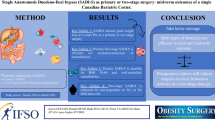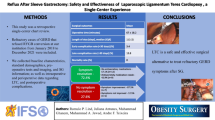Abstract
Introduction
The aim of this study is to retrospectively analyze the incidence of complications after two-stage laparoscopic biliopancreatic diversion with duodenal switch (Lap BPD-DS) in high-risk super-obese patients and explore the possible predictive factors of specific complications after laparoscopic sleeve gastrectomy (SG).
Methods
High-risk patients—body mass index (BMI) > 50 kg/m2 with at least two major comorbidities: type 2 diabetes, obstructive sleep apnea syndrome (OSAS), hypertension—undergoing two-stage laparoscopic BPD-DS were retrospectively analysed. The SG pouch volume was 100–150 ml; in the second stage, the common channel and the alimentary loop were 100 cm and 150 cm, respectively.
Results
Eighty-seven patients (50 female, 57.5%) underwent SG (two open). The mean age was 41.8 ± 10.22 years with BMI of 55.2 ± 6.69 kg/m2. Four patients had Prader–Willy syndrome. Fourteen (16.46%) patients (6 female, 42.8%) had postoperative complications such as bleeding, fistula, pulmonary embolism, transitory acute renal failure, and abdominal abscess. One patient died at postoperative day 5 of pulmonary embolism. One patient was reoperated for hemoperitoneum by laparoscopy. The risk of complications after SG was lower in patients where reinforcement of the suture line was used (0.492), while it was higher in men (1.780). Neither difference was statistically significant [p = not significant (NS)]. After 9–24 months, 27 patients (BMI 43 ± 8 kg/m2) underwent a second stage of BPD-DS (two open). Major postoperative complications were registered in eight patients (29.6%): three bleeding, four duodeno-ileal stenosis and one rhabdomyolysis. Two cases of internal hernia required laparoscopic reoperation. The reoperation rate was 1/85 (1.2%) after SG and 2/27 (7.4%) after second stage.
Conclusions
Complications after SG greatly decrease after the learning curve period and can be successfully managed without need of reoperation. Suture-line reinforcement, at least selectively in the middle-upper portion of the staple line and in super-super-obese patients, is recommended to decrease the incidence of specific complications.




Similar content being viewed by others
References
Marceau P, Hould FS, Simard S, Lebel S, Bourque RA, Potvin M, Biron S (1998) Biliopancreatic diversion with duodenal switch. World J Surg 22(9):947–954
Ren CJ, Patterson E, Gagner M (2000) Early results of laparoscopic biliopancreatic diversion with duodenal switch: a case series of 40 consecutive patients. Obes Surg 10(6):514–523 discussion 524
De Csepel J, Burpee S, Jossart G, Andrei V, Murakami Y, Benavides S, Gagner M (2001) Laparoscopic biliopancreatic diversion with a duodenal switch for morbid obesity: a feasibility study in pigs. J Laparoendosc Adv Surg Tech A 11(2):79–83
Gagner M, Boza C (2006) Laparoscopic duodenal switch for morbid obesity. Expert Rev Med Devices 3(1):105–112
Regan JP, Inabnet WB, Gagner M, Pomp A (2003) Early experience with two-stage laparoscopic Roux-en-Y gastric bypass as an alternative in the super-super obese patient. Obes Surg 13(6):861–864
Aggarwal S, Kini SU, Herron DM (2007) Laparoscopic sleeve gastrectomy for morbid obesity: a review. Surg Obes Relat Dis 3(2):189–194
Baltasar A, Serra C, Perez N, Bou R, Bengochea M, Ferri L (2005) Laparoscopic sleeve gastrectomy: a multi-purpose bariatric operation. Obes Surg 15(8):1124–1128
Lee CM, Cirangle PT, Jossart GH (2007) Vertical gastrectomy for morbid obesity in 216 patients: report of two-year results. Surg Endosc 21(10): 1810–1816. Epub 2007 Mar 14
Gumbs AA, Gagner M, Dakin G, Pomp A (2007) Sleeve gastrectomy for morbid obesity. Obes Surg 17(7):962–969
Silecchia G, Boru C, Pecchia A, Rizzello M, Casella G, Leonetti F, Basso N (2006) Effectiveness of laparoscopic sleeve gastrectomy (first stage of biliopancreatic diversion with duodenal switch) on co-morbidities in super-obese high-risk patients. Obes Surg 16(9):1138–1144
Clinical Issues Committee of American Society for Metabolic and Bariatric Surgery (2007) Sleeve gastrectomy as a bariatric procedure. Surg Obes Relat Dis 3(6): 573–576
Catheline JM, Rosales C, Cohen R, Bihan H, Fournier JL, Roussel J, Benichou J (2006) Laparoscopic sleeve gastrectomy for a super-super-obese patient with situs inversus totalis. Obes Surg 16(8):1092–1095
Langer FB, Bohdjalian A, Felberbauer FX, Fleischmann E, Reza Hoda MA, Ludvik B, Zacherl J, Jakesz R, Prager G (2006) Does gastric dilatation limit the success of sleeve gastrectomy as a sole operation for morbid obesity? Obes Surg 16(2):166–171
Moon Han S, Kim WW, Oh JH (2005) Results of laparoscopic sleeve gastrectomy (LSG) at 1 year in morbidly obese Korean patients. Obes Surg 15(10):1469–1475
Mognol P, Chosidow D, Marmuse JP (2005) Laparoscopic sleeve gastrectomy as an initial bariatric operation for high-risk patients: initial results in 10 patients. Obes Surg 15(7):1030–1033
Langer FB, Reza Hoda MA, Bohdjalian A, Felberbauer FX, Zacherl J, Wenzl E, Schindler K, Luger A, Ludvik B, Prager G (2005) Sleeve gastrectomy and gastric banding: effects on plasma ghrelin levels. Obes Surg 15(7):1024–1029
Milone L, Strong V, Gagner M (2005) Laparoscopic sleeve gastrectomy is superior to endoscopic intragastric balloon as a first stage procedure for super-obese patients (BMI > or = 50). Obes Surg 15(5):612–617
Consten EC, Dakin GF, Gagner M (2004) Intraluminal migration of bovine pericardial strips used to reinforce the gastric staple-line in laparoscopic bariatric surgery. Obes Surg 14(4):549–554
Consten EC, Gagner M, Pomp A, Inabnet WB (2004) Decreased bleeding after laparoscopic sleeve gastrectomy with or without duodenal switch for morbid obesity using a stapled buttressed absorbable polymer membrane. Obes Surg 14(10):1360–1366
Acknowledgments
The authors are greatly indebted to Luca Milone, MD (New York Presbyterian Hosptial, Weill College of Medicine of Cornell University, NY, USA, Department of Surgery) for his invaluable help in statistical analysis and in reviewing the manscript.
Author information
Authors and Affiliations
Corresponding author
Rights and permissions
About this article
Cite this article
Silecchia, G., Rizzello, M., Casella, G. et al. Two-stage laparoscopic biliopancreatic diversion with duodenal switch as treatment of high-risk super-obese patients: analysis of complications. Surg Endosc 23, 1032–1037 (2009). https://doi.org/10.1007/s00464-008-0113-8
Received:
Revised:
Accepted:
Published:
Issue Date:
DOI: https://doi.org/10.1007/s00464-008-0113-8




